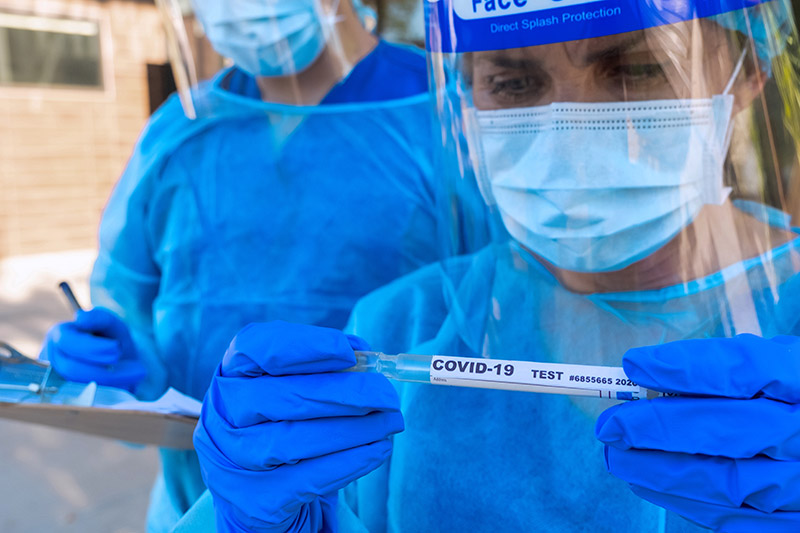COVID-19 and Chemicals

SARS-CoV-2, the virus that causes the COVID-19 disease, has infected millions of people worldwide and has killed hundreds of thousands1. The pandemic has galvanized the global scientific and medical communities, resulting in over 21,000 scientific publications in just the first 6 months of 2020.
An important early conclusion is that the severity of COVID-19 is dependent upon the pre-existing health condition of the patient that compromises the ability to fight the disease.
According to the U.S. Center for Disease Control, the most common pre-existing conditions associated with severe disease include chronic obstructive pulmonary disease, obesity, coronary artery disease, and diabetes. Importantly, these chronic diseases are also linked to hazardous chemical exposures – especially chemicals that interfere with the endocrine system.
Endocrine Disrupting Chemicals (EDCs) are identified by their ability to cause harm by interfering with our hormone systems2, 3. Unfortunately, EDCs surround us in our daily lives, and include chemicals used as flame retardants, in plastics production, in food packaging, in pesticides, and in other applications. Communities exposed to more of these hazardous chemicals have been shown to have higher rates of these pre-existing chronic diseases. Thus, EDC exposure compounds the harm and impact of COVID-19.
Some argue that if an EDC caused an adverse effect, then everyone exposed would exhibit that effect. But this is like saying that if cigarettes cause cancer, then everyone who smokes would have cancer. In addition, because not everyone smokes, studies can compare cancer rates in the smoking population with that of the population of non-smokers. This strategy is not possible for many EDCs because everyone is exposed – there is no unexposed comparison population. Finally, we are exposed to a mixture of hundreds of chemicals – even at birth4, without our knowledge or permission5. Both smoking and EDCs are hazardous to your health and should be avoided.
It is also important to recognize that exposures to EDCs exert a toll not only on health but on the economy6-10. Thus, countries with developing economies and economies in transition that have a burden of chronic disease attributable to EDC exposures, are also facing more significant severe disease in relation to COVID-19. Data from the United States clearly show this trend.11
The relationship between COVID-19 disease severity and EDC exposures clearly demonstrates that current government policies are not protecting our health. The data from COVID-19 deaths reveal that EDC exposure has a direct effect on health, and also compromises the ability of whole populations to respond to a pandemic. Human populations need to be protected from EDC exposures, and the old business model based on risk assessment procedures have failed us. Known EDCs should be replaced with safe alternatives. People should be provided with information that helps them make choices, much like cancer warnings on cigarettes packages. COVID-19 has highlighted the failures in public health policies and the need to protect us from hazardous EDCs.
Scientific Articles
-
State of the Science of Endocrine Disrupting Chemicals 2012.
Bergman A, Heindel JJ, Jobling S, Kidd KA, Zoeller RT, eds. Geneva, Switzerland: World Health Organization; 2013.
This comprehensive review, assembled by a multinational team of experts, provides an introduction to EDCs, a review of their adverse effects globally, and a review of environmental and human exposure levels.
-
EDC-2: The Endocrine Society's Second Scientific Statement on Endocrine-Disrupting Chemicals.
Gore AC, Chappell VA, Fenton SE, Flaws JA, Nadal A, Prins GS, Toppari J, Zoeller RT. Endocr Rev. 2015:er20151010.
The Endocrine Society – the oldest and largest scientific and medical society focusing on hormones – developed a review of the field of EDCs using a multinational team of experts.
-
COVID-19, an opportunity to reevaluate the correlation between long-term effects of anthropogenic pollutants on viral epidemic/pandemic events and prevalence.
Tsatsakis A, Petrakis D, Nikolouzakis TK, Docea AO, Calina D, Vinceti M, Goumenou M, Kostoff RN, Mamoulakis C, Aschner M, Hernandez AF. Food Chem Toxicol. 2020.
An excellent contemporary review of the literature linking the severity of COVID-19 infection and exposures to pollutants.
-
Manufacturing doubt about endocrine disrupter science - A rebuttal of industry-sponsored critical comments on the UNEP/WHO report "State of the Science of Endocrine Disrupting Chemicals 2012".
Bergman A, Becher G, Blumberg B, Bjerregaard P, Bornman R, Brandt I, Casey SC, Frouin H, Giudice LC, Heindel JJ, Iguchi T, Jobling S, Kidd KA, Kortenkamp A, Lind PM, Muir D, Ochieng R, Ropstad E, Ross PS, Skakkebaek NE, Toppari J, Vandenberg LN, Woodruff TJ, Zoeller RT. Regul Toxicol Pharmacol. 2015.
This is a scholarly analysis of the strategies employed by lobbyists to discount scientific evidence of EDC harm using a case study approach.
-
Endocrine Disruptors and Health Effects in Africa: A Call for Action.
Bornman MS, Aneck-Hahn NH, de Jager C, Wagenaar GM, Bouwman H, Barnhoorn IEJ, Patrick SM, Vandenberg LN, Kortenkamp A, Blumberg B, Kimmins S, Jegou B, Auger J, DiGangi J, Heindel JJ. Environ Health Perspect. 2017 Aug 22;125(8):085005. doi: 10.1289/EHP1774.
The commentary summarizes the scientific evidence presented by experts at the First African Endocrine Disruptors meeting. We describe a "call to action" to utilize the available scientific knowledge to address the impact of EDCs on human and wildlife.
News Articles
-
COVID-19, EDCs & the Immune System
How toxic chemicals contribute to COVID-19 deaths
Environmental Health News - Read the article
Endocrine-disrupting chemicals weaken us in our COVID-19 battle
Environmental Health News - Read the article
PFAS chemicals—the other immune system threat (Op-ed)
Environmental Health News - Read the article
Pollution, COVID-19 & Impacted Communities:
The Fullest Look Yet at the Racial Inequity of Coronavirus
New York Times - Read the article
Omission of air pollution from report on Covid-19 and race ‘astonishing’
The Guardian - Read the article
The Connections Between Race, Pollution, and Covid-19
UnDark.org - Read the article
COVID-19 Deaths & Air Pollution
Air pollution linked to raised Covid-19 death risk
BBC - Read the article
Exposure to air pollution and COVID-19 mortality in the United States: A nationwide cross-sectional study medRxiv - Read the article
Industry Tactics: Misinformation & Rollback’s during COVID-19 Pandemics
Rightwing thinktanks use fear of Covid-19 to fight bans on plastic bags
The Guardian - Read the article
US EPA advances rollbacks while coronavirus pandemic rages
American Chemical Society (ACS) - Read the article
“The dangers of opinion masquerading as fact in science journals”
Environmental Health News - Read the article
COVID-19 and Toxic Treatments
List Of Potentially Toxic Hand Sanitizer Brands Grows
Forbes - Read the article
Health & Science Advisors
![]()
Riana Bornman, MBChB, DSc, MD
Faculty of Health Sciences, Department of Urology
University of Pretoria, South Africa
![]()
Thomas Zoeller, PhD
Professor of Biology
University of Massachusetts, United States

Pamela Miller
IPEN Co-Chair
Executive Director, Alaska Community Action on Toxics, United States
![]()
Tadesse Amera, PhD
IPEN Co-Chair
Director, Pesticide Action Nexus, Ethiopia
Footnotes
1 COVID-19 Dashboard. 2020. at https://coronavirus.jhu.edu/map.html.)
2 Gore AC, Chappell VA, Fenton SE, et al. EDC-2: The Endocrine Society's Second Scientific Statement on Endocrine-Disrupting Chemicals. Endocr Rev 2015:er20151010.
3 Bergman A, Heindel JJ, Jobling S, Kidd KA, Zoeller RT, eds. State of the Science of Endocrine Disrupting Chemicals 2012. Geneva, Switzerland: World Health Organization; 2013.
4 Houlihan J, Kropp T, Wiles R, Gray S, Campbell C. Body Burden: The Pollution in Newborns. Washington, D.C.: Environmental Working Group; 2005.
5 Zoeller RT. The consequences of status quo chemical policy are becoming increasingly clear. Environmental Health News 2018.
6 Ghassabian A, Trasande L. Disruption in Thyroid Signaling Pathway: A Mechanism for the Effect of Endocrine-Disrupting Chemicals on Child Neurodevelopment. Front Endocrinol (Lausanne) 2018;9:204.
7 Wassenaar PNH, Trasande L, Legler J. Systematic Review and Meta-Analysis of Early-Life Exposure to Bisphenol A and Obesity-Related Outcomes in Rodents. Environ Health Perspect 2017;125:106001.
8 Trasande L, Lampa E, Lind L, Lind PM. Population attributable risks and costs of diabetogenic chemical exposures in the elderly. Journal of Epidemiology and Community Health 2017;71:111-4.
9 Attina TM, Hauser R, Sathyanarayana S, et al. Exposure to endocrine-disrupting chemicals in the USA: a population-based disease burden and cost analysis. The Lancet Diabetes & Endocrinology 2016;4:996-1003.
10 Bellanger M, Demeneix B, Grandjean P, Zoeller RT, Trasande L. Neurobehavioral deficits, diseases, and associated costs of exposure to endocrine-disrupting chemicals in the European union. J Clin Endocrinol Metab 2015;100(4):1256-1266.
11 vom Saal FS, Cohen A. How toxic chemicals contribute to COVID-19 deaths. Environmental Health News 2020. https://www.ehn.org/toxic-chemicals-coronavirus-2645713170.html
